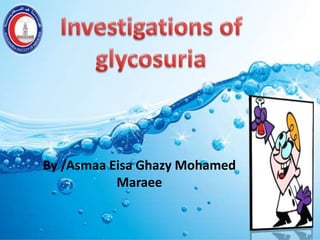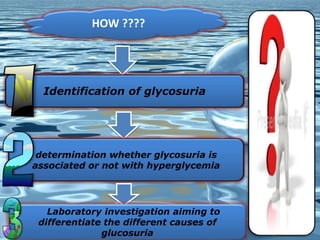Investigations of glycosuria
- 1. By /Asmaa Eisa Ghazy Mohamed Maraee
- 3. HOW ???? Identification of glycosuria determination whether glycosuria is associated or not with hyperglycemia Laboratory investigation aiming to differentiate the different causes of glucosuria
- 4. Identification of glycosuria Glucose Oxidase Test This is done useing commercial, plasticcoated reagent strips
- 6. Patient preparation Explain Check for drug history False negative Equipment
- 7. Procedure Collect aspecimen after 30 to 45 minutes of drinking water Precautions not to contaminate test strip container tightly closed Store it in a cool place Don't use discolored
- 8. Result Normal Findings Abnormal findings No red coloure of stripe No glucose is present in urine Red-colored product Glycosuria is present as in diabetes mellitus, and other causes Interfering factors contamination of the specimen failure to keep the reagent strip container tightly Use of reagent strips after the expiration date Presence of reducing substances
- 10. determination whether glycosuria is associated or not with hyperglycemia Fasting plasma glucose 2-hour postprandial blood sugar
- 11. fasting plasma glucose (FPG) test if one’s body cannot generate enough insulin or cannot appropriately respond to insulin, fasting blood sugar levels will stay high.
- 12. Result normal range 70 mg/dL to 99 mg/dL prediabetes diabetes 100 mg/dL to126 mg/dL above 126 mg/dL
- 13. Interfering factors • In afternoon rather than in the morning. • much time passes between when the blood is drawn and the lab processes the sample personal habits two abnormal results from tests taken on two different days are required to confirm a diagnosis. previous or current medical conditions
- 15. Reference ranges Less than 140 not use just one test result to diagnose the condition. normal range diabetes 200 and above
















